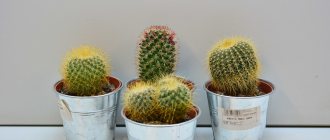» Signs » Signs and superstitions associated with Hatiora
0
1716
Article rating
Hatiora is a cactus that grows naturally in the tropical forests of Brazil and pleases the eye with abundant flowering. In the article we will tell you what signs and superstitions exist about Hatiora.
Signs and superstitions associated with Hatiora
Popular beliefs
Hathiora is known as a bearer of controversial fame. All signs associated with it are divided into positive and sharply negative. Let's start with the second group.
- Hatiora is popularly called the flower of drunkards , because its presence in the house creates a desire to drink alcohol, both in the owner and the hostess. And the more flowers a cactus has, the more relentlessly the owners of the premises will abuse it.
- They also say that if a flower is kept in the house, it can lead to family breakdown . Therefore, it should not be in rooms where the owners spend a lot of time, especially in the marital bedroom. Even the appearance of Hatiora (dangling stems with leaves) is very reminiscent of hanging plants growing in hanging pots - symbols of female loneliness and sadness.
- Many consider the plant to be an energy vampire ; supposedly it takes away positive energy with its leaves and only gives out negative energy. Therefore, it is recommended to keep Hatiora away from places where the family spends a lot of time.
Giving cacti will only be allowed if they have flowers. Otherwise, the relationship between the person giving and the person receiving the gift will instantly deteriorate. And if you accept the non-blooming Hathiora, then quarrels and disagreements in the house will become a constant occurrence.
Ways to neutralize negativity
Of course, even the most superstitious housewife is unlikely to blame the cactus for all family problems. However, those who are accustomed to attach great importance to signs should exercise caution and neutralize possible negativity. After all, as you know, popular beliefs work on faith - the more you listen to them, the more often they come true. For very superstitious flower lovers, there is only one answer to the question “is it possible to grow hatiora at home” - it’s better not to. Especially if family relationships are already strained.
Popular wisdom recommends not keeping dangerous flowers in living quarters, bedrooms, and children's rooms. A pot of succulent would look much more appropriate in the kitchen or living room.
A very good solution would be to keep the hatiora at home near the computer, microwave oven, or router. There it is needed to cleanse the energy field - it is believed that cacti block harmful radiation.
The best place for a pot with a cactus is considered to be a cabinet or window at the entrance to the apartment. This is a sure way to ward off ill-wishers from your home.
Why does it bloom?
Positive signs are associated with the flowering of a cactus.
- The sudden appearance of flowers on a plant that has not flowered for a long time symbolizes the onset of great good changes.
- Flowering of Hatiora in the house of an unmarried woman means that she will soon get married.
- And if the plant blooms in the house of a married couple where there are no children yet, then they will appear very soon. Even by the shade of the flowers, you can determine the gender of the unborn child: dark - there will be an heir, light - a girl.
- If you already have children and there are no plans to add new family members, but Hatiora has blossomed, the family will be in for a monetary gain, a successful acquisition, or unexpected income.
It turns out that in order to neutralize negative signs, you need to make an effort so that the plant blooms.
Family well-being indicator
People have noted one curious property of the succulent. The more tense the situation in the family, the more active and magnificent the “drunkard’s dream” grows. This makes the plant a kind of relationship indicator. Succulents are believed to absorb negativity. Therefore, the worse the energy in the apartment, the better the prickly plant feels.
There is a positive side to this belief about hathior in an apartment. The more lush the plant, the more negativity it can absorb and, therefore, clean out. Therefore, if “male tears” first grew and then blossomed, the omen is considered very good - relationships in the family will improve, the financial situation will strengthen, and very soon everything will certainly get better.
Feng Shui meaning of a flower
According to Feng Shui, Hatiora has the ability to effectively suppress negative energy by absorbing low vibrations that negatively affect household members. Therefore, experts recommend placing the flower in small rooms (narrow corridors, bathrooms). Here the succulent will prevent stagnation of energy.
A good place for a cactus is the living room or kitchen, where guests often gather. With its help, communication with friends and acquaintances will become more sincere.
Hatiora is simply irreplaceable in public institutions and offices . It helps cope with stress among employees, extinguishing negative emotions, and also clears the space where many people accumulate, extinguishes aggression and helps to improve the situation.
Characteristics of Hatiora and species diversity
Hatiora has a fibrous superficial root system and is distinguished by the absence of leaves in the usual sense. The plant's stems consist of small, individual evergreen segments that form roots that allow the plant to absorb moisture from the air. Different types of plants have different shapes of segments: flat, pin-shaped, cylindrical.
Good to know!
It should be noted that color appears only on young shoots, which over time become woody and turn brown. The flower stalks look like small bells with many petals of different colors: yellow, pink, red. Flowering begins in spring and lasts several weeks.
The crown of the succulent is spreading and resembles a skeleton, which is why one of the names of hatiora is dancing bones. At home, the flower can reach half a meter in height. Due to the strong branching of the shoots, the plant needs support.
Only a few types of hatiora are grown at home:
- Hathiora pink. The most striking representative of Cacti with drooping shoots. Each segment is ribbed, green with several pink streaks, covered with small white roots. The length of each segment is 25 mm. Beautiful pink buds form at the ends of the shoots, from which tubular flowers up to 4 cm in diameter subsequently bloom.
Hathiora pink - Hatiora Grezer. It has drooping shoots consisting of bright green segments up to 25 mm, which over time become brown at the base. The flowers are bright, large pink or bright scarlet. Hatiora Grezer
- Hathiora saltwort. The shoots are erect, consist of cylindrical segments, bright green, densely branched. Each lobe reaches 28 mm. At the ends of the shoots, bright yellow, bell-shaped flowers develop.
Hathiora saltwort - Hathiora Hermine. This epiphytic succulent is distinguished by short shoots consisting of small cylindrical segments (up to 5 cm) with small jagged dark green shades. Flowers with a diameter of 2 to 2.5 cm have a bright pink color. The cactus itself reaches a height of 30 cm.
Hathiora Hermine - Hathiora salicorniformes. A succulent in the form of a bush with hanging shoots consisting of club-shaped segments up to 5 cm long. An adult plant reaches 50 cm in height. The buds are bright yellow in the form of bells, 1 cm long. As the plant grows, its shoots gradually become woody and turn brown.
Hathiora salicorniformes
Is it possible to keep a houseplant in the house?
If you find the right place for a succulent, then you can and even should keep it in the house, as it will only bring benefits.
Benefit
Hatiora has the ability to protect a person from evil otherworldly forces, the evil eye and damage , so the presence of a flower in the house will drive away bad people from the family. This plant also pleases with its bright flowers when it is cold outside the window. Isn't this a benefit - a good mood?
How can it be dangerous?
One version of Hatiora's unwanted presence in the house can be explained from a scientific point of view. Allegedly, this succulent is a poisonous plant. However, there is no confirmation of this information, since Hatiora is not included in the official list of poisonous plants. But if you are still afraid of this unofficial fact, place the plant away from children and animals.
Dangerous gift
To place a cactus in an apartment, signs advise buying it. But accepting it as a gift or giving it yourself is extremely undesirable. It is believed that a gift will lead to a quarrel with the donor.
But the sign can be easily neutralized. To make a gift safe, you should pay some money for it. The amount is not important. The very fact of payment turns the gift into a purchase, and the negative will thereby be repaid.
Where is the best place to put it?
The plant feels great where there is frequent quarrel or negative energy . It simply feeds on bad fibers. Therefore, it is best to place cacti in places where negative, heavy energy is most likely to accumulate, or where people with unfriendly messages may be present.
- It’s not for nothing that Hatiora can often be seen on office desks and near computers. Placing it near the gadget at home is also an ideal option.
- The kitchen is a great place, as soot from gas and fat will nourish Hatiora, replacing negativity.
- Hallway. Here the succulent will absorb negative energy emanating from uninvited guests, ward off damage, evil eyes and other bad intentions aimed at the owners.
To believe signs or not is everyone’s personal choice. Forewarned is forearmed, and you now know how to place Hatiora so that she brings only benefit. In response, the plant will delight you in winter with bright flowers and lift your spirits.
How to Get a Healthy Plant That Will Protect and Bring Joy
Attention, in order for Hatiora to bestow only positive energy, the flower needs careful care. A healthy plant will not bring negativity into the house.
It is very important to choose a place with the right lighting, despite the fact that the birthplace of the flower is Brazil, Hatiora, like chamedorea, does not like direct sunlight, which can burn its leaves. It requires constant watering and a constant temperature of at least +15 C. It would be useful to fertilize with fertilizers, especially before the flowering period, but after the flowers fade, Hatiora needs to be replanted, replacing up to 90% of the entire soil. And of course, you need to make sure that the flower is not crowded in the pot.
External description
The bush is compact in size with abundant branching - it grows up to 40 cm in height and width.
The annual growth is small - a relatively tall specimen can be formed only by 10 years and will still not be higher than 50-180 cm. In this case, the shoots can bend to the ground under the weight and require support.
This evergreen plant looks especially original in the spring and summer, during flowering. The cactus blooms with orange, pink, crimson, red and yellow bells with numerous petals.
In home and natural conditions, flowering most often occurs in the spring, which is why the succulent is also called the “Easter cactus.”











